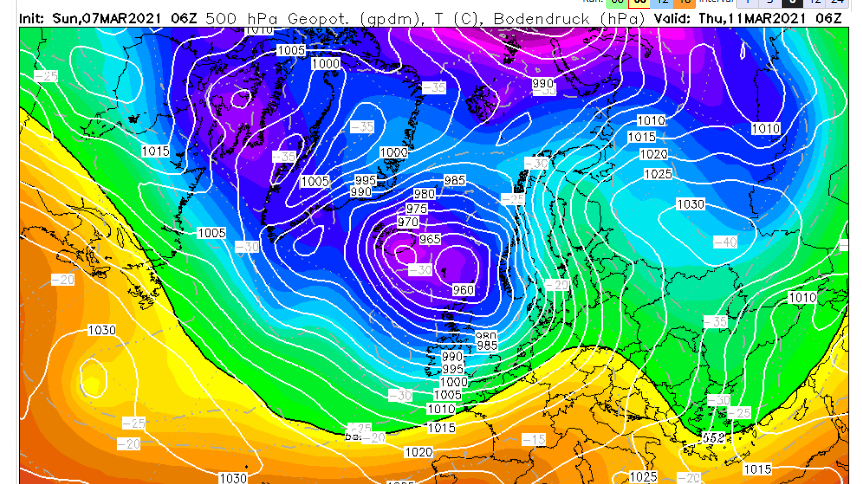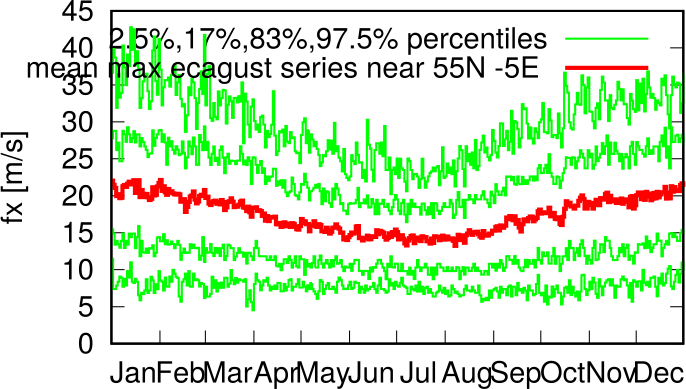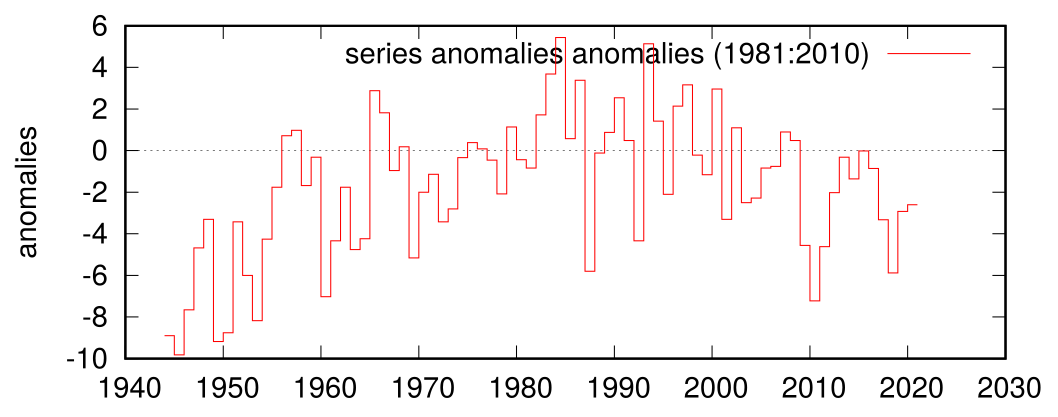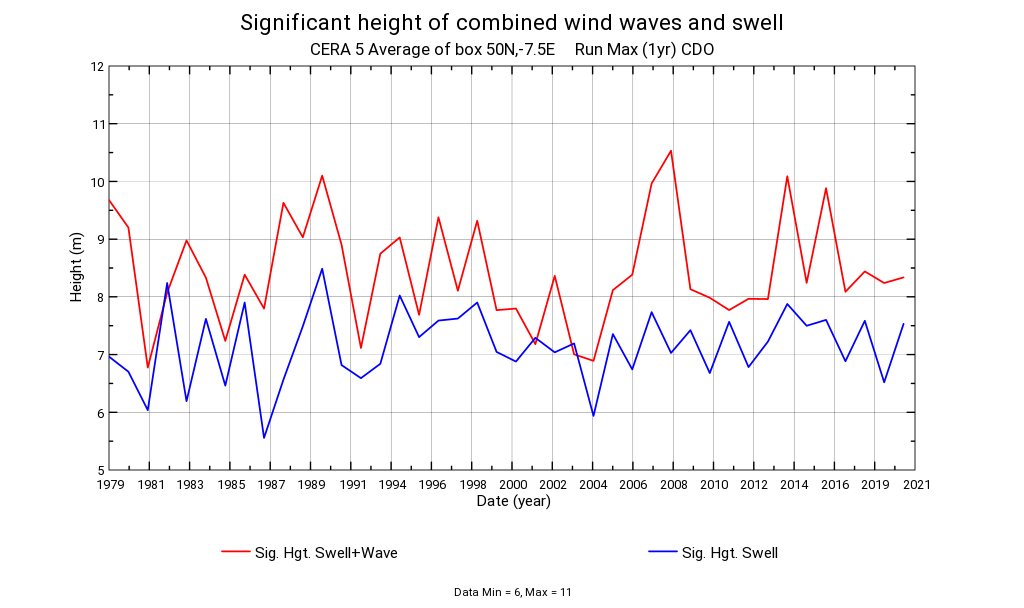Len W
Mar 7, 2021, 9:42:30 AM3/7/21
to Weather and Climate
Could this be Storm Evert?
Arriving on Wed/Thurs

Len
Julian Mayes
Mar 9, 2021, 11:36:47 AM3/9/21
to Weather and Climate
Hi Len, is there actually any evidence for the frequency of gales or strong winds peaking around either equinox? I can understand people noticing an increase at the autumn eq. as we are going into the season of autumnal and winter gales. Spring is another matter - as we proceed to the annual minimum of the W type and pressure gradients in May.
Just wondering.
Julian
Len W
Mar 9, 2021, 6:20:17 PM3/9/21
to Weather and Climate
Evening Julian,
Not sure there is much proof for an increase in gales per se. And we are not talking about at the equinox, more so as we approach the
equinox ,
windiness increases across the baroclinic zone.
Len
Graham Easterling
Mar 10, 2021, 3:44:20 AM3/10/21
to Weather and Climate
In Penzance
(which is of course very sheltered for west Cornwall) gale frequency is simply associated with the coldest part of the year, the equinox has no affect. Peak just after the winter solstice. In fact in Penzance the average number of gales over the last 30 years
So
January 1.8
February 1.3
March 0.7
April 0.4
May & June >0 to <0.1
July & August 0
September >0 to <0.1
October 0.7
November 1.1
December 1.5
March has seen some severe gales, but not the frequency of November-February, just part of the downward trend into Summer.
It's a bit like the off used phrase, 'cloud breaking to the lee of high ground' which suggests these sheltered coasts are sunnier, not true in Devon & Cornwall. The sunniest spots in Devon & Cornwall being the west facing exposed coasts of the Lizard, the Lands End peninsula & the north coast, as the MetO sunshine records & maps show.
Graham
Penzance
Graham Easterling
Mar 10, 2021, 3:56:35 AM3/10/21
to Weather and Climate
Just checked days with gusts>60mph at my site, there have been 27 (around 1 per year). All in October to February, apart from 1 in March, and that was a real classic.
Gust of 73mph, but the worst sea conditions in living memory, according to many who are in a good position to know.
Worth a look, click images for larger version
There was no weather warning, I did query why, I won't bore you with the reply.
Graham
Penzance
Julian Mayes
Mar 10, 2021, 5:32:00 AM3/10/21
to Weather and Climate
Len, I'm afraid I don't follow what you mean about as we approach the equinox , windiness increases across the baroclinic zone. You are suggesting that specific date does have some effect.
By the way, the main who set this place up, Xmetman, Bruce Messer, still lurks here and y'day he sent me this link to where he has discussed this topic....
He confirms Graham's observation that we just have a strong seasonal cycle in strong winds and no equinoctial effect. However, the graphs he shows (Lamb classification gale index) do show a dip in mean air pressure at the end of March which I'd been unaware of (unrelated to strong winds or equinoxes).
Julian
Len
Mar 10, 2021, 5:47:46 AM3/10/21
to Weather and Climate
The weather is highly variable around the vernal equinox for good dynamical reasons.
The break up of the stratospheric polar vortex in the spring is called the final warming.
Planetary wave activity is upset as the atmosphere in mid lats adjusts to more solar input.
There is a perception of windiness, when everyone is looking forward to the more settled weather and less windiness of summer.
You have to wait until May for the reality of that.
So in some ways the strong winds around the vernal equinox are the last hurrah of winter and stick in peoples minds because they are looking forward to more pleasant weather.
Wind not up to gale force here yet but
an equinoctial gale is forecast to arrive on cue tonight.
😉
😉
😉
Len
Wembury
Graham Easterling
Mar 10, 2021, 6:38:45 AM3/10/21
to Weather and Climate
Yes, it's a shame Bruce no longer posts here.
If you read this Bruce, please come back!
Graham
Penzance
Smartie
Mar 10, 2021, 5:07:44 PM3/10/21
to Weather and Climate
A dataset of max recorded gusts from 10 Irish stations ( at least 10-year continuous for each station) (European Climate Assessment & Dataset plotted with KNMI Data Explorer) going back to 1945. There appears to be an increase in 'storminess' during June and a tendency for an increase beginning in October and possibly as early as August



The most striking thing about the data is the multi-decadal trend with a decline in 'storminess' since the 1990s (remarked on previously and elsewhere)

A 26-year history of gusts at the K13 buoy in the North Sea suggests March is still a winter month in that area (in terms of 'storminess')

Julian Mayes
Mar 10, 2021, 5:31:32 PM3/10/21
to Weather and Climate
Thanks for this, David - yes, the time series is interesting as I thought there were some conflicting data-sets around. Is the graph published or will it be?
The low values in 1960, 1987 and 2010 are each in years with a low 'westerly' score over the UK so fewer depressions deepening over the NE Atlantic and then passing over UK - 1960 being the very wet, cyclonic year with a southward deflected storm track. Maybe the latter factor discouraged really severe deepening. I remember compiling mean annual wind speeds for London some years ago and finding that 1987 was the least windy year within what was probably the 1961-90 period. Of course, no-one believed me!
Julian
Graham Easterling
Mar 11, 2021, 4:15:34 AM3/11/21
to Weather and Climate
Thanks for all that
The most striking thing about the data is the multi-decadal trend with a decline in 'storminess' since the 1990s (remarked on previously and elsewhere)
I've probably mentioned the fairly dramatic decrease in gale frequency in Cornwall since the 1990s too often already! Looking back through the records 1990s were not unique. Lambs 'The English climate shows a gale frequency over the tip of Cornwall of 20-30 hales per annum (1918/1937). Far less than this century so far, & much more typical of the '90s.
I rather suspect depressions have got stuck in mid Atlantic much more of late, as based on frequent checks on Sevenstones (off Lands End) I'm not sure there has been much change in the frequency of large swells (>20'). I haven't recorded details, in retrospect I would have, so if there is any data available from Sevenstones or any of the buoys in the SW approaches which may provide evidence of this, I'd appreciate it. From a surfing perspective there have been a number of occasions with huge surfable waves on the north Cornwall coast, under light southerly winds & a deep near stationary low mid/west Atlantic in recent years.
I think storminess continues later into Spring in the North Sea than on the Atlantic coast, after all the SST is very low and depression have a habit of diving down the North Sea (Spring northerlies.) SST currently 5-6C of East Anglia, 10C at Scilly.
Graham
Penzance
Smartie
Mar 11, 2021, 12:03:14 PM3/11/21
to Weather and Climate
The KNMI explorer doesn't have useful buoy data and/or all the needed reanalysis variables but here is significant swell height and swell+wave height from the coupled ERA5 Reanalysis for a 5deg box centred at 50N,-7.5E for the years 1979-present ( 6hr/day data, 1-year max).
I've no idea how much relation this might bear to reality.
(Data: Copernicus Climate Service processed with CDO & Panoply)

Reply all
Reply to author
Forward
0 new messages
